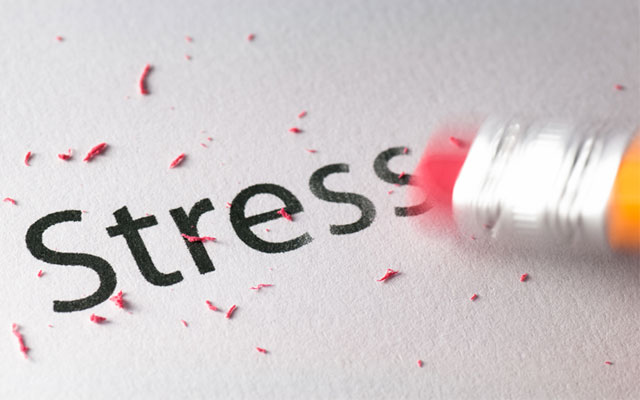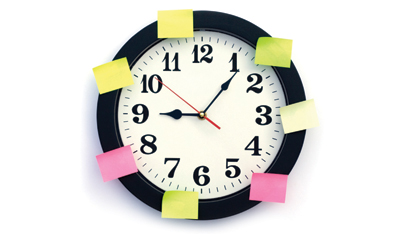We’ve hear a lot of bad news about stress: that it reduces our life satisfaction, that it leaves us more susceptible to a host of physical and mental illnesses, and – according to new research – that it can even shrink and age our brains. Stress, by most counts, has become a major public enemy.
But there’s also some good news about stress, like the fact that when handled properly, it can catalyze growth and positive change. Or the fact that stress can also function as a clarion call to awareness, and, as a result, can actually present us with a chance to better understand and claim what we most want in our lives.
“The closest Chinese word for stress consists of two characters; one signifies ‘danger’ and the other ‘opportunity,'” notes Paul Rosch, MD, a clinical professor of medicine and psychiatry at New York Medical College and president of the American Institute of Stress in Yonkers, N.Y.
People who’ve triumphed over stress, Rosch emphasizes, have done so not by entirely eliminating it from their lives, but rather by filtering and responding to stressful experiences in more constructive ways.
So how does one manage stress to minimize its damage and maximize its potential gifts? What are the keys to transforming stress into a stimulus for growth – as opposed to a trigger for breakdown?
We talked with several experts to figure out the best ways to proactively identify, buffer and constructively engage stress, rather than become a passive or reactive victim of it. Below are some of the best tools and suggestions for neutralizing and deflecting avoidable stress before it strikes, as well as for cultivating resilience and bouncing back from stressors that make it past our initial defenses.
A Matter of Perception
Most experts agree that the discomfort and damage we associate with stress generally occurs more as the result of our perceptions of – and subsequent reactions to – triggering circumstances, as opposed to being caused by the circumstances themselves.
“Many times we create our own stress because of faulty perception,” says Rosch. “Take a roller-coaster ride. Some people sit in the back with their jaws clenched, grasping the retaining bar, while in the front you see the wide-eyed thrill seekers yelling and relishing every steep plunge. So is a roller-coaster ride stressful or not?”
The answer, Rosch says, lies in how each rider frames the event: “What distinguishes the people in the front of the roller coaster from the people in the back is their perception of the event, their expectations and, most importantly, their sense of perceived control. All of our clinical and animal research confirms that the perception of not having any control is always stressful. [In the case of the roller-coaster riders], neither group really has any more or less control than the other, but their perceptions are entirely different – and that’s what stress is all about.”
So, is the answer for the white-knuckled people in the back of the roller coaster to simply give up scary amusement-park rides? That’s one option, Rosch acknowledges, but a better strategy is reframing the event causing the anxiety so that it’s no longer perceived as a source of unbearable stress. By empowering people to monitor and adjust their automatic reactions, he says, “you can teach them to move from the back of the roller coaster to the front.”
Spheres of Control
Very often, say stress-management experts, stress occurs at the intersection of a high perception of responsibility and a low perception of control. In other words, when we are (or feel) responsible for something, but we have (or feel that we have) little influence over its outcome, stress inevitably results.
Thus, the first key to tackling it is clarifying what you do and don’t have real control over – and then aligning your responsibility level accordingly. Sometimes merely acknowledging that something falls beyond your realm of control (and, therefore, your responsibility) is enough to reduce your stress. In other cases, acquiring enough control to actively improve your situation is a better tactic.
“There are some stressful circumstances you can do something about,” says Rosch, “and some that you can’t hope to avoid. The problem is, most of us never bother to distinguish between the two.”
For example, Rosch notes, there’s probably no getting around the stress that results from, say, the death of a loved one. While you can choose how you approach the grieving process, you can’t control the loss itself. This is one reason acceptance (which involves acknowledging both a lack of control and responsibility) is such an essential part of recovering from the stress of loss.
On the other hand, if something like a long commute is causing your stress level to rise, you may have to consider whether you’re better off resigning yourself to the situation (low control, low responsibility), or choosing to change some things about it (higher control, higher responsibility). In the latter case, Rosch suggests, you might approach your supervisor and explain that you would be a more productive and satisfied employee if you could work at home two days a week.
If your supervisor agrees to accommodate you, great. But even if he or she doesn’t, Rosch notes, you’ve by no means exhausted your options for regaining an additional measure of control. You can explore alternative solutions (e.g., a different job, a different home) or you can simply decide to alter your response to the situation at hand.
“Instead of trying in vain to find a shortcut to work and making rude gestures while you’re driving,” suggests Rosch, “you can say, ‘OK, I’m going to take this time to listen to a book on tape that I haven’t had time to read.’ By the time you reach the company parking lot, you might find that you actually want to stay in your car a few extra minutes to hear the end of the story.”
In this instance, instead of being acted upon and adopting an attitude of learned helplessness, hopelessness or martyrdom, you dealt directly with the situation. Essentially, you reclaimed control by upgrading your response to the circumstances, if not the circumstances themselves.
It’s important to remember, though, that stress is generally a call for change of some kind. While adjusting your response to challenging circumstances can help you experience less stress in the short term, tolerating a miserable or offensive situation for too long can lead to more pervasive stress – and a lower quality of life – over time. So it’s important to assess what the stressors in your life are asking from or telling you, and to address the components of “opportunity” (as well as danger) inherent in them.
Accept or Eject
To identify those stressors you can take on and those you can’t, Rosch suggests first sitting down and making a list of everything stressing you out. Then, separate the stressors into those you can (and choose to) manage and those that, at least for the moment, you need to accept and stop fretting about.
That’s just the approach Alice Jones (not her real name) took when some politically charged policy issues arose at her workplace last year and she found her personal beliefs and convictions at odds with those of her employers.
“It wasn’t just typical work stress,” Jones says. “It hit me on a very emotional level because my employer’s position clashed with my own overall values, and yet – aside from expressing my opinion – I had no influence on the decision-making. As much as I cared about the outcome, I had no real control over the situation.”
Compounding Jones’s workplace stress was a series of family and health crises that had made the previous year very stressful on a personal level. Realizing she could no longer remain in this “emotional vortex,” and thatshe was also not yet prepared to leave her job, Jones resolved to instead focus on managing her own energy better.
On a return flight from a trip to San Francisco, she vowed to commit herself to a long-term daily yoga practice and to develop a set of “daily intentions.” The intentions would provide a framework for her choices and for the proper direction of her personal will.
As part of her intention-setting process, Jones developed a short list of questions she now runs through every morning to prioritize her essential tasks and responsibilities. Her questions include things like,”What’s important for me to accomplish today?” “What’s a good use of my energy?” and “Which of my current concerns are within my control, and which are outside of it?”
In addition to identifying the stressors Jones can’t control and segregating them from ones she chooses to confront head-on, her daily intentions address how she wants to eat that day and how she can work in some exercise (even if it’s just a 10-minute walk).
Although there’s no one-size-fits-all cure for stress, says lifestyle coach and dietitian Libby Mills, MS, RD, developing a personalized stress-abatement plan like Jones’s is a good place start. Staying focused on conscious choices and priorities not only wins you back your sense of control, she notes, it also gives you the opportunity to proactively create areas of success and satisfaction in your life that help you keep your remaining stresses in perspective.
Creating these small wins is better by far, she says, “than just going with the flow and then feeling victimized by the situation.”
Compartmentalizing is another strategy for dealing with stress, Mills suggests. Too often, we allow stress from one area or moment of our lives to bleed into and poison others. The result:Our reactions grow out of proportion to the original trigger, and our net stress burdens rise needlessly.
If you feel your stress level rising in response to a troubling circumstance, Mills advises these tips: “Set a time limit. Give yourself five to 10 minutes to experience and hash through your stress, and then time’s up. During the final minute, decompress and try to get back to your regular routine.” Once you’ve calmed down, you’ll have an opportunity to make more thoughtful and productive choices – and to take away useful learning from the experience.
The Involved Heart
As noted, on the flip side of attempting to limit the damage caused by stress lies the possibility of transforming it into something positive. One of the most fertile environments for this transformation exists within the realm of the body’s heart, says psychologist Deborah Rozman, PhD, author with Doc Childre of Transforming Stress: The HeartMath Solution for Relieving Worry, Fatigue and Tension.
In the last 20 years, Rozman says, the heart has been reclassified from just a pump to a hormonal gland that has its own “brain” of sorts that collects information from the entire body and then communicates it to the brain. “The heart sends more information to the brain than the brain sends back down to the heart,” she asserts.
When we’re experiencing stress, the heart’s pattern gets jerky and arrhythmic and signals a chaotic pattern to the brain. “The heart tells the brain, ‘Go into survival mode. Shut down higher cortical functions. Look for a pattern of when we were threatened in the past that matches this one.’ As a result, the old fight-or-flight response comes up,” Rozman explains.
In contrast, when we perform simple relaxation or coherence exercises that encourage us to feel positive emotions – love, appreciation, tolerance – heart-rhythm patterns are smooth. “The brain then tells the frontal lobes that all systems are go, and you are able to open up to your most creative, intuitive, clear thinking,” Rozman says. “It’s safe to develop your potential and to transform stress into creative energy.”
If we accept the idea that stress has equivalent capacities for shutting us down or opening us up to something better, then we must also accept the challenge of responding to it constructively. Seen from this perspective, the call to “put stress in its place” ceases to be an exercise in resistance, and becomes instead an exploration – and expansion – of our resilience.
6 Strategies to Transform Stress
- Distinguish between unavoidable stressors and stressors you can do something about. “Don’t waste your time and energy in a frustrating attempt to influence things you can’t possibly change,” advises Paul Rosch, MD, a clinical professor of medicine and psychiatry at New York Medical College and president of the American Institute of Stress in Yonkers, N.Y.
- Adopt a stress-abatement plan. “When you have a stress-management strategy and you track your progress with it,” says lifestyle coach Libby Mills, MS, RD, you’ve got a platform for success. “Even if you succumb to challenges in one area, you can look back on your progress and commend yourself on how far you have come. One stressful incident isn’t a complete sinking of the ship.”
- Stress and release. When you experience something stressful, Mills advises, appreciate and learn from it – then let it go. Don’t let stress hang over you like a cloud that follows you everywhere.
- Set boundaries. “It’s just not possible to please everybody,” says Rosch. Plus, the more things you agree to make “your problem,” the less time and energy you have to manage your resident stressors well. Setting healthy boundaries is a way of taking responsibility for your life and warding off external manipulations. “People will respect you more,” says Rosch, “when you respect yourself and your personal time.” (Struggle with setting boundaries? See “How to Set Clear Boundaries“.)
- Start with the heart. When our heart-rhythm patterns are smooth and coherent, says psychologist Deborah Rozman, PhD, we can transform stress into creative energy. To achieve better heart coherence in a jiffy, try the Quick Coherence technique, outlined in Rozman and Doc Childre’s Transforming Stress: The HeartMath Solution for Relieving Worry, Fatigue and Tension: Focus your attention in the area of your heart, and imagine you are breathing slowly and gently through your heart to a count of five in, five out. While continuing to breathe through your heart to this rhythm, imagine or reexperience a positive feeling or attitude, such as caring, compassion or appreciation. By holding a positive emotion as you breathe, you’ll create greater coherence in your heart rhythms and affect a shift in your neurological responses to boot. (According to HeartMath experts, breathing alone doesn’t affect as significant or as lasting an impact on the body.)
- Forget perfection. Recognize that stress management is a learning process – it takes practice. “One of the things that yoga has taught me,” says former stress case Alice Jones, “is how to practice something without carrying too much judgment into it. I have learned how to let go.”
This article originally appeared as “Put Stress In Its Place”.




This Post Has 0 Comments